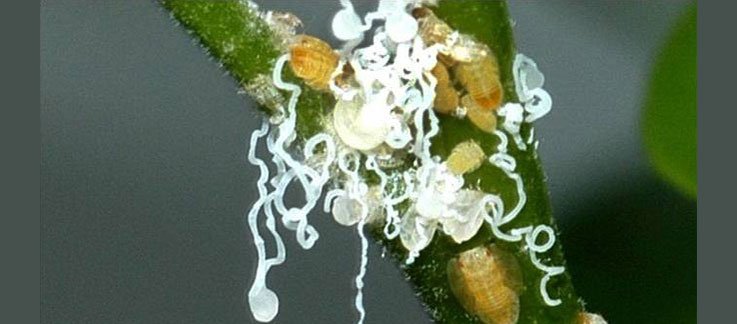Alameda Sun, Wednesday, February 8, 2023
by Linda Carloni, Alameda Backyard Growers
Alameda’s front and back yards contain many citrus trees. Selected lemon and mandarin orange varieties are particularly common here. Citrus trees are easy to care for, but they can be prone to insect damage on the leaves from aphids, leafminers, and thrips, which can all be managed.
One insect pest on citrus trees, however, has much more serious consequences. This insect pest is the Asian citrus psyllid (ACP), and it can carry the citrus greening, or Huanglongbing (HLB) disease, one of the most serious citrus plant diseases in the world. There is no known cure for or effective control of HLB; HLB kills the trees it infects, in as little as five years.
Along with all citrus trees, HLB can infect Indian curry leaf, orange jessamine and several other closely related ornamental plants.
HLB was first found in the U.S. in Florida and has seriously damaged citrus there. The Asian citrus psyllid was first detected in Southern California in 2008; HLB was detected in Los Angeles as well as in Texas in 2012. The Asian citrus psyllid has now fully infested Southern California.
The insect has moved north and has been found in Alameda County, including in Oakland. As of July 2022, HLB has not been detected in our county. All of Alameda County is under quarantine for the psyllid.
Since there is no cure for HLB, the only way to reduce its damage is to reduce the number of Asian citrus psyllids. Backyard citrus growers can be a big help.
Inspecting Citrus Trees
Check trees monthly spring through fall. Look especially for nymphs, the relatively stationary stage that hatches from the eggs, on the new shoots and leaves.
The adult psyllids are very small – about the size of an aphid. They have mottled brownish wings and feed with their head down and their “tail” in the air, a characteristic posture of this species.
The nymphs can be even smaller. Key to locating the nymphs is the white waxy curly tubules that they excrete, which are quite visible and are characteristic of this kind of psyllid.
Look at the color of the leaves as well. An early sign of HLB: individual leaves yellowing in an asymmetric pattern on just one limb or section of the tree canopy. Citrus leaves can turn yellow or have yellow patterning for various reasons, including nutrient deficiencies, but the yellowing caused by HLB can be distinguished.
Yellowing due to nutrient deficiency is generally symmetrical – it occurs equally and in very similar patterns on each side of the main leaf vein. HLB yellowing is asymmetrical – the leaves have different amounts and patterns of yellowing on either side of the main leaf vein.
Here’s a good resource for how to inspect for Asian citrus psyllids and HLB: https://ucanr.edu/sites/ACP/Homeowner_Options/Homeowner_Management
Backyard growers in the city of Alameda who believe they have found the Asian citrus psyllid or a tree with HLB should immediately call the free statewide pest hotline at 800-491-1899.
How Else to Help
- If putting in a new citrus tree, only purchase from a reputable local nursery.
- Don’t move citrus plants or clippings outside the area. Don’t move backyard citrus fruit outside the area unless all leaves and stems have been removed.
- Control ants – Ants around citrus trees need to be controlled, because ants protect the ACP nymphs from their natural predators and parasites. If there are ants crawling up a citrus tree, use a band of sticky material (for example, Tanglefoot) around the trunk to prevent the ants from climbing up.
- Chemical pesticides are not recommended to control ACP until it’s confirmed that this psyllid is present. Find information on managing confirmed ACP here: https://ipm.ucanr.edu/QT/asiancitruscard.html
Linda Carloni is on the board of Alameda Backyard Growers (ABG), a nonprofit organization dedicated to teaching Alamedans how to grow food. ABG offers online and in-person educational programming.
Read the original article in the Alameda Sun here – and support our local newspaper by buying a subscription!

